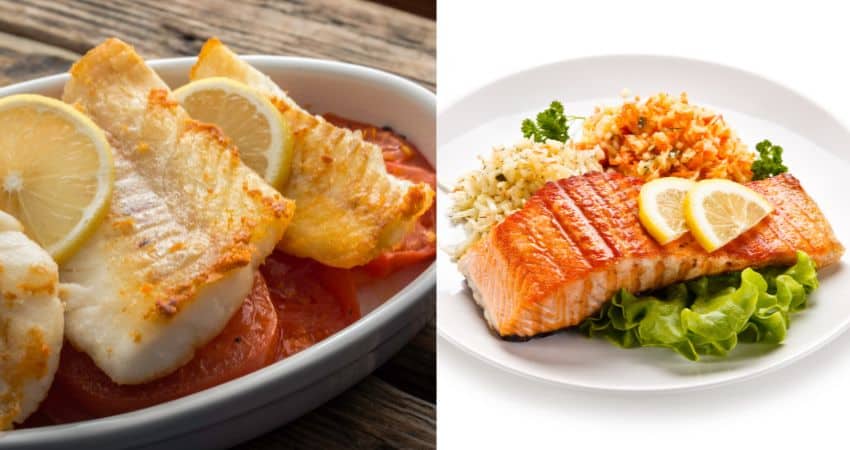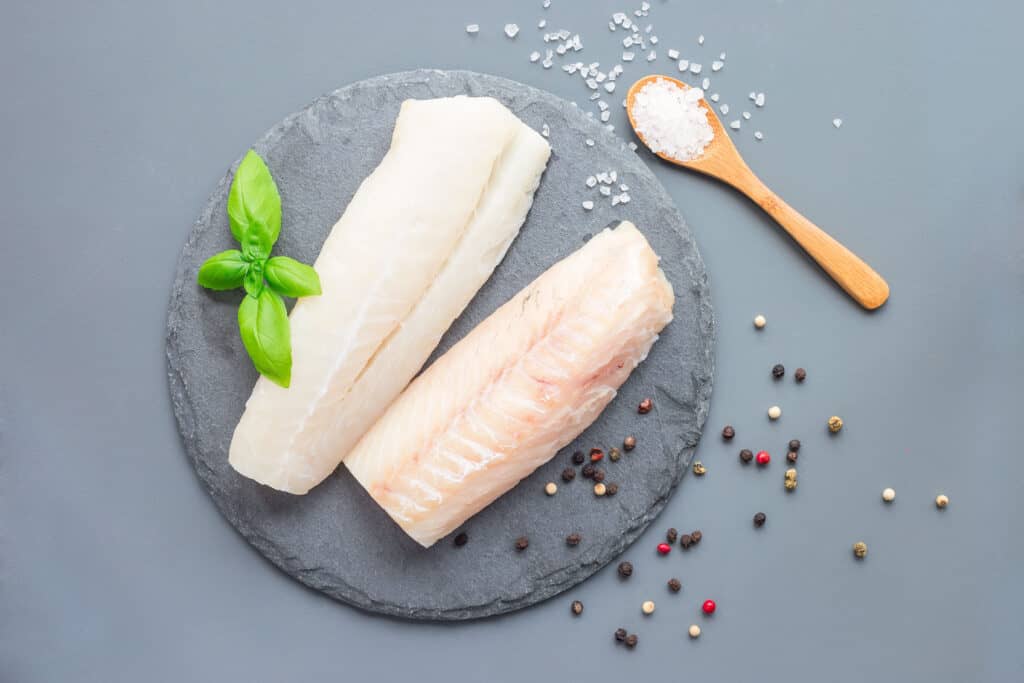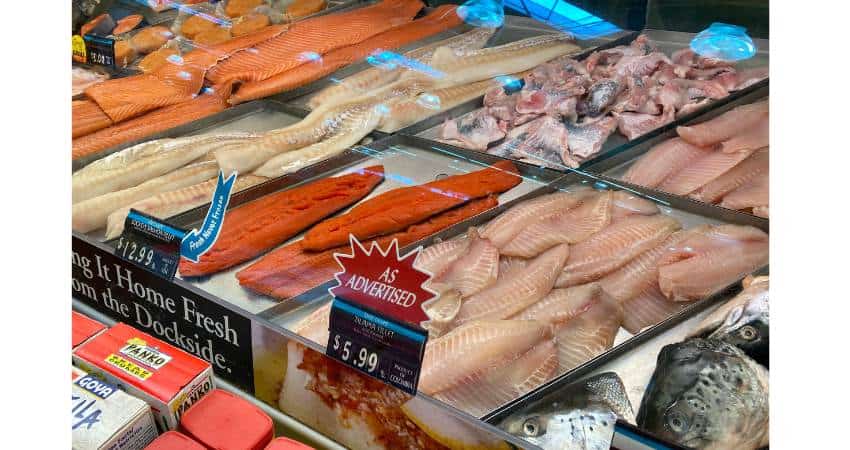Cod vs Salmon: Is One Better?
Cod and salmon are excellent options offering many health benefits. Let’s find out if one is better than the other.
Salmon is better than cod because it contains more healthy omega-3 fatty acids and minerals than cod. Salmon contains a larger percentage of vitamins like thiamin, riboflavin, niacin, B5, B6, B12 and folate. Although cod contains less calories and fat, most of salmon’s fats are heart healthy and beneficial.
Cod is no slouch and contains a good number of nutrients too. This article will list each nutrient and how much each fish contains. In addition, I’ll examine how they compare in taste and texture, if you can substitute one for the other, their mercury levels and more.
Cod vs Salmon: Nutrition Facts

As a Certified Health Coach many clients ask me about food comparisons including cod and salmon. I purchase and consume either fish every week. Therefore, I have researched this topic in the past and present. Let’s examine them closely.
First, let us take a look at the nutrition facts for cod and salmon.
| Nutritional Value | Cod, raw | Salmon, raw |
| Serving Size | 4 Ounces | 4 Ounces |
| Calories | 93 | 161 |
| Calories from Fat | 7 | 65 |
| Total Fat | 0.8 g | 7.2 g |
| Saturated Fat | 0.1 g | 1.1 g |
| Trans Fat | 0 g | 0 g |
| Omega-3 | 0.22 g | 1.96 g |
| Cholesterol | 49 mg | 62 mg |
| Sodium | 61 mg | 50 mg |
| Potassium | 468 mg | 555 mg |
| Total Carbohydrates | 0 g | 0 g |
| Dietary Fiber | 0 g | 0 g |
| Sugar | 0 g | 0 g |
| Protein | 20 g | 23 g |
| Vitamin A | 2% | 2% |
| Calcium | 1% | 1% |
| Thiamin | 7% | 21% |
| Vitamin B6 | 21% | 71% |
| Niacin | 15% | 56% |
| Phosphorus | 33% | 32% |
| Copper | 4% | 32% |
| Vitamin C | 1% | 0% |
| Iron | 2% | 5% |
| Riboflavin | 6% | 33% |
| Vitamin B12 | 43% | 150% |
| Magnesium | 9% | 8% |
| Vitamin B5 | 3% | 38% |
| Zinc | 5% | 7% |
Fats
When you look at the nutritional information of salmon and cod above, you will notice that salmon has a lot more fat in it than cod. However, the fat is healthy.
Some of the fat in both salmon and cod are omega-3 fatty acids, which our bodies can not produce on their own. Not all the fats in salmon and cod are omega-3s, but many of the fat fatty acids in salmon and cod are.
Why are omega-3 fatty acids so beneficial? Omega-3 fatty acids are heart healthy and help keep cholesterol levels lower and arteries healthy.Two of the fatty acids, DHA and EPA are associated with lowering blood pressure and improving the health of blood vessels ((National Center for Biotechnology: Marine Omega-3 Supplementation and Cardiovascular Disease)).
Salmon contains about nine times the amount of omega-3s than cod. This difference is what really separates the two and gives salmon the edge over cod.
Sodium
There is sodium in everything, and cod and salmon are no exceptions. Often times people will add salt, soy sauce, garlic and other seasonings to cod and salmon. This adds more sodium to the meal, but cod and salmon do not contain much of it.
However, cod and salmon have slightly different levels of sodium. If you want to avoid sodium, choose salmon over cod since it contains a little less.
Potassium

Potassium is one of the best minerals for your body. It provides your body with a variety of nutrients keeping your body strong. It is also good at combating high sodium intake because it helps the body reduce fluids and rids excess sodium ((American Heart Association: How Potassium Can Help Control High Blood Pressure)).
This process helps to reduce blood pressure. Luckily, salmon and cod both contain potassium. Salmon possesses more potassium than cod but not by much.Vitamins and Minerals
Vitamins and minerals are essential and ensure that your body functions well. Just like sodium, you need specific amounts of each vitamin and mineral every day. Both cod and salmon contain many essential vitamins and minerals for the body.
Cod has slightly more magnesium and vitamin C than salmon. Salmon contains more thiamin, riboflavin and B vitamins. However, both salmon and cod provide the body with many essential nutrients.
Magnesium is also beneficial for the heart and improves blood pressure. It achieves this by helping the blood vessels to relax. In addition, magnesium helps control other nutrients like calcium and potassium which are beneficial for blood pressure ((National Institutes of Health: Magnesium)).
Cod vs Salmon: The Difference
Salmon is a freshwater and saltwater fish while cod is a saltwater fish only. Cod fish grow larger and weigh more than salmon. Cod is found in the colder waters of the Atlantic and Pacific Ocean while salmon inhabit the Atlantic and Pacific oceans and offshore rivers and streams.
Cod vs Salmon: Taste and Texture
Cod is a lean fish with a mild flavor. The Atlantic cod taste a tiny bit sweeter than a Pacific cod. Of all the marine fish, cod may come the closest to tasting like chicken. The flesh has a firm texture with large flakes.
Salmon has a tender, buttery texture. It has a rich, oily taste and more bold than cod. Wild-caught salmon has a leaner texture than farm-raised. Salmon is more oily than cod because of its high omega-3 fatty acids content.
The taste and texture of either fish may vary depending on the farming method, wild or farm raised and the cooking method used.
My Poll and Taste Test at Home
I wanted to get the opinion of real people like you and me. Therefore, I wanted to conduct my own research and contacted my clients, readers and members of food groups I belong to. I asked them which of the two fish they preferred.
- 47% said they preferred the taste of salmon.
- 43% said they preferred the taste of cod.
- 10% said they had no preference, or it depended on their mood.
I then set up a blind test taste at my home. I prepared both fish the same way using the same seasonings. Three out of four people, 75% chose the salmon. They said the flavor was better.
Cod vs Salmon: How To Cook
Cod and salmon can be cooked the same ways. The following are different ways to cook them:
- Pan seared.
- Pan griiled.
- Pan fried.
- Baked.
- Poached.
- Slow roasted.
- Grilling.
- Broiling
Best Flavors
Cod and salmon are pretty similar foods. Although they come from different fish, they both offer a delicious fishy flavor. Recipes for each fish use similar seasonings and flavors. Lemon juice, lemon slices and lemon vinaigrette all go well with cod and salmon. Most salmon and cod recipes call for lemon flavoring in some form.
Both salmon and cod also taste great with garlic seasoning. Both fish are also regularly seasoned with cayenne pepper, paprika, and a variety of fresh herbs.
When cooking cod specifically, primarily use lemon flavoring and top it with some fresh herbs. On the other hand, many people enjoy eating plain salmon.Add salt or pepper to the fish when cooking, grilling or baking it for a subtle flavor profile.
However, many people also cook their salmon or cod with honey. It sweetens that salty fish and is surprisingly good. For salmon, of course, you cannot forget soy sauce, which is a sushi staple.
Best Sides
Finding a side to eat with a cod or salmon dinner doesn’t have to be difficult. Choose a simple side dish with similar seasoning when serving either of these fish for dinner.
Another way to elevate your cod dish is to serve homemade tartar sauce. Just coat and fry up some cod, and dip it in the tartar sauce.
Another side to serve with cod is lemony potatoes. These flavors complement the mild tastes of the cod well.
Other simple side dishes to serve with cod or salmon include green beans, coleslaw and rice pilaf.
Salmon, on the other hand, tastes delicious when dipped or coated in garlic sauce. You can then add the same garlic sauce to most greens for a well-rounded meal. Vegetables that work well with a garlic sauce include broccolini, bok choy, brussels sprouts, asparagus, snap peas or green beans.
Experiment with putting garlic sauce on some of your favorite vegetables.
You can also pair a variety of potato side dishes with salmon. If you want potatoes as the side for your salmon dish, season them with lemon and rosemary.
Cook salmon with garlic, lemon and rosemary to compliment the fish’s natural buttery flavors. If the side dish has garlic, it will go well with the main salmon dish.
In the end, it does not matter much what you put on your cod or salmon. As long as it suits your tastes and dietary needs, it is up to you. Cod and salmon are both healthy, lean meats.
Cod and Salmon Substitutions
There are times when you go to the supermarket the type of fish you need for a recipe isn’t going to be available. You may have a freezer full of cod and need to use them.
Cod and salmon can substitute for each other when cooking seafood, although they have different textures and tastes. They both can be cooked using the same methods like slow-roasted, poached or searing in a pan.
When substituting cod for salmon, certain sauces that go well with an oily fish like salmon won’t go as well with a cod3.
When substituting one type of fish for another, try following these tips:
- Pick similar fillets, whole fillet or cross section.
- Always choose the same weight and size.
- If the recipe calls for skinless, choose skinless and visa versa.
- When grilling a firm texture is more important.
- Substitute a fatty or lean fish for the same.

Cod and Salmon Mercury Levels
The FDA and EPA have issued warnings and suggestions regarding mercury levels in fish and consuming them4.
They established a list of fish that are best and good choices based on their mercury levels. They also have a third section which are choices to avoid because they have the highest mercury levels.
Cod and salmon have similar levels of mercury. Both fish are listed on the FDA’s best choices of fish to consume regarding their mercury levels. They recommend eating no more than two to three servings a week.
Always check with a physician prior to eating new foods or changing your dietary habits.
The Cost of Cod and Salmon

The cost of either cod or salmon will differ depending on your location, supermarket, fresh or frozen and whether it’s farm raised or wild caught.
Salmon is slightly more expensive than cod. The average cost for salmon is $12.49 per pound while the average cost for cod is $11.49 per pound. The cost will vary depending on location, whether it is farm-raised or wild-caught, fresh or frozen.
I visited and checked my local Shoprite Supermarket and other markets for the current prices of each.
- Fresh, farm raised cod
- $9.99 per pound.
- Fresh, wild caught cod
- $12.99 per pound
- Fresh, farm raised Atlantic salmon
- $9.99 per pound
- Fresh, wild caught Coho salmon
- $14.99 per pound
If you have any questions to ask me about this article don’t hesitate to comment below or email us. You can find an email on our contact page.
Read Next – More Salmon vs Fish Articles!
Halibut vs Salmon: Which Is Better?
Shrimp vs. Salmon: A Complete Comparison
Char vs. Salmon – A Complete Comparison
Sardines vs Salmon: A Complete Comparison
Salmon vs Chicken: Which Is Healthier?
Salmon Oil vs Fish Oil: Which Is Better?
- Nutrition Value: Salmon, raw [↩]
- Nutrition Value: Cod, raw [↩]
- Sea Grant North Carolina: Fish Flavors and Substitutions [↩]
- FDA: Advice about Eating Fish [↩]
